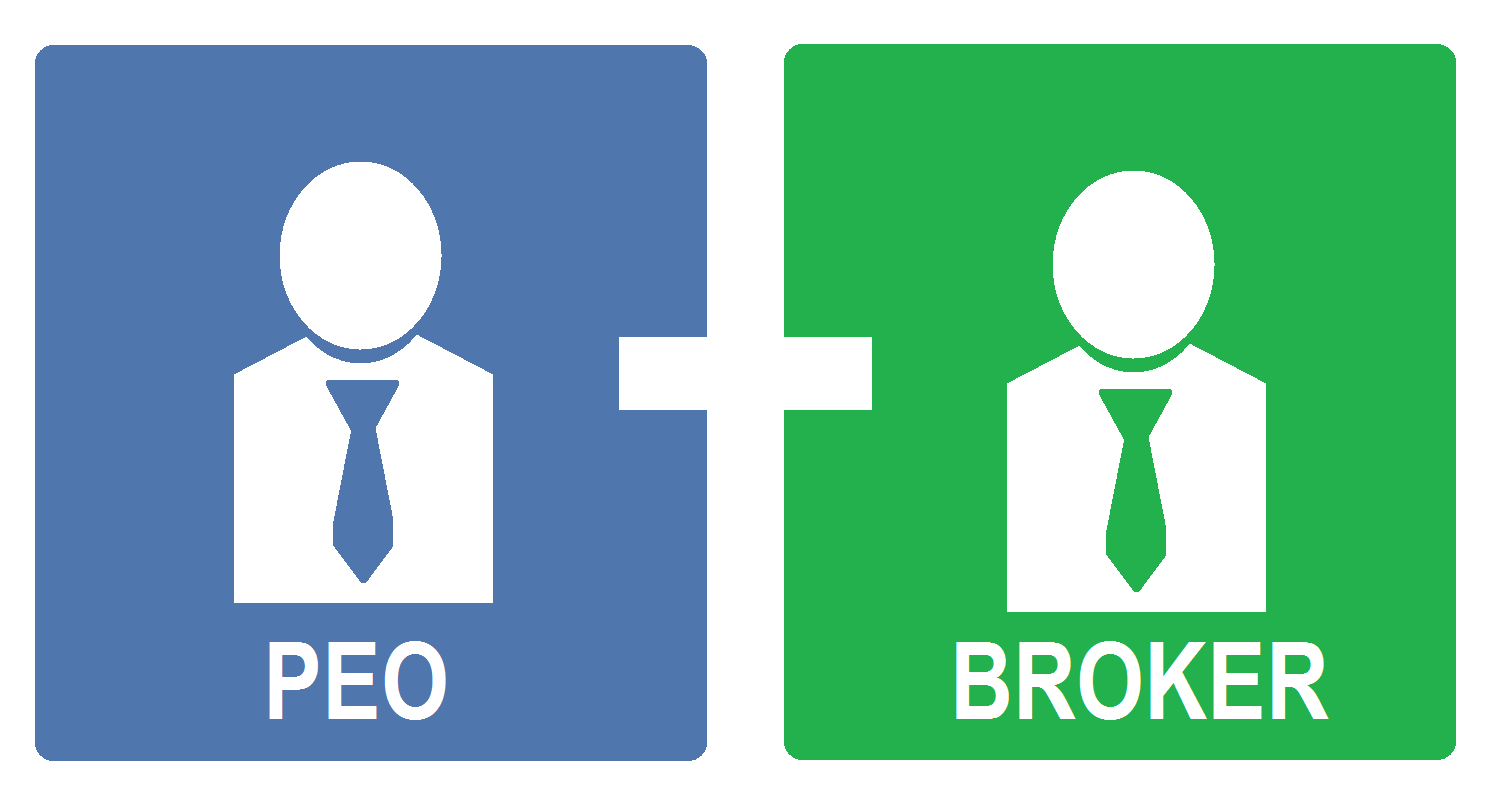Professional Employer Organization
A professional employer organization (PEO) is an outsourcing firm that provides services to small and medium sized businesses (SMBs). Typically, the PEO offering may include human resource consulting, safety and risk mitigation services, payroll processing, employer payroll tax filing, workers’ compensation insurance, health benefits, employers’ practice and liability insurance (EPLI), retirement vehicles (401(k)), regulatory compliance assistance, workforce management technology, and training and development. The PEO enters into a contractual co-employment agreement with its clientele. Through co-employment, the PEO becomes the employer of record for tax purposes through filing payroll taxes under its own tax identification numbers.
Insurance Broker
An Insurance Broker is an intermediary between the insurance carrier and the insured client. A broker will represent a number of markets and typically offer various insurance products. The broker serves as an advocate for their client, handles negotiations with the underwriters, and provides experienced representation to the carriers on behalf of their client.
Relationship
PEOs often partner with insurance brokers to procure new business opportunities. The broker submits perspective clientele to the PEO for consideration. The PEO, and their carrier partners, underwrite the account and provide a quote when underwriting approves moving forward. Since PEOs offer much more than solely insurance, PEO representatives typically accompany the broker to prospect meetings. This allows the PEO to provide an overview of their program while answering any questions a prospect may have. If the PEO signs the prospect, the broker is paid commissions in accordance with that PEO’s broker commission structure.
Symbiotic Relationship
PEOs and Brokers enter a mutually beneficial relationship when partnering. Each party receives benefits from the relationship as outlined below.
Benefits to a PEO
When a PEO utilizes brokers as part of a channel go-to-market strategy, the PEO can tap into a vast external sales force, i.e. brokers. This is a cost-effective approach for the PEO considering they only pay the broker for production, i.e. closed business. By utilizing a channel approach, the PEO can carry a smaller internal sales force than a direct sales strategy. This helps the PEO mitigate dead costs with under-performing sales professionals whom have not met the validation curve. Moreover, using a broker strategy allows PEO sales professionals to spend more time in front of potential clientele in lieu of hunting. Assuming the internal sales professional is adept at their job, spending more time in front of prospects equates to higher new business production.
Benefits to a Brokerage
When a broker partners with a PEO, it can offer more than solely insurance to its clientele. The PEO’s offering acts as a differentiator for the brokerage. Typically, when a brokerage tries to differentiate itself from competition, the differentiation comes with a price tag. However, when partnering with a PEO, a brokerage can now offer all that the PEO market provides, without any capital outlay for the differentiation. Moreover, once an account is written, the PEO handles the majority of servicing for the client. This means that a brokerage could place a large book of business with the PEO while not adding headcount to its own internal service staff. This equates to increase profit margins for the brokerage due to lower SG&A expenses.
Additionally, most PEOs have procured insurance at scale. Meaning, they have offerings that may not be readily available to small and medium sized business (SMBs) customers. A broker that partners with a PEO can tap into the markets, that would otherwise be unavailable to their clientele. Finally, most PEOs have client retention rates at, or above, 90% annually. This higher retention rate creates revenue predictability at the broker level.
Potential Downside
While there are many benefits for both the PEO and broker partner to form a relationship, there are also areas that could be problematic.
Potential Downside for PEOs
One potential issue is that some brokers will try to “block” the market with PEOs. In other words, a broker will solicit a quote from a PEO only to shelve the quote. In this scenario, the broker never had any intention of providing the quote to the insured, but rather was looking to block the market so that another producer couldn’t come in with a quote from the PEO.
Another potential issue is brokers that don’t grant the PEO representative access to the prospect during the sales process. This typically results in poor expectations set at a client level as the broker is not trained on selling the PEO option, articulating the PEO’s functionality, nor setting appropriate expectations for the relationship.
Finally, some brokers view a PEO market as an “insurer of last resort.” In other words, the broker will try to place a poor account elsewhere and will finally send it to the PEO when it doesn’t fit anywhere else. This creates a bad client selection process and is a waste of time for the PEO. Ironically, some PEOs market themselves in a way that courts this type of behavior.
Potential Downside for Brokers
A potential issue for brokers when partnering with a PEO is circumvention. The PEO receives the submission from the broker and then solely has a relationship with the client while alienating the broker. While it is appropriate that the PEO have direct connection with the customer during the relationship, this does not mean that the broker should be alienated from pertinent communication.
Another potential issue for brokers working with PEOs is mid-term carrier changes. For example, some PEOs have changed workers’ compensation carriers’ multiple times in a policy year. This is more prevalent with PEOs that are part of an investment portfolio. Changing carriers and/or renewal dates may have a material effect on a client’s experience modification.
Finally, some PEOs haven’t been overly transparent with their pricing model. As a result, a broker may have difficulty understanding the pricing for the program which could impact their ability to advise their client.
No Downside Necessary
The downsides illustrated for both the PEO and broker do not need to become a reality. If the PEO and broker agree on certain rules of engagement, many issues that could plague an otherwise beneficial relationship, can be avoided.
Conclusion
When the relationship between a PEO and broker is set appropriately, both parties win. There are advantages for each party to partner with one another, both with their business practices and financially. Moreover, when an SMB has the combination of a good insurance broker and good PEO, the client has two valuable advocates on its behalf. Combined, the broker and PEO operations benefit one another. It can be argued that each party is stronger together than apart. The key is to weed out subpar brokers and PEOs, in order to partner with best in class operations.
Author
Rob Comeau is the CEO of Business Resource Center, Inc., a business consulting and M&A advisory firm to the PEO industry. Rob has met with thousands of brokers in his career and represented or consulted with a large number of PEOs. To contact Rob, you may email him at rob.comeau@biz-rc.com, or visit Business Resource Center, Inc. at www.biz-rc.com.

